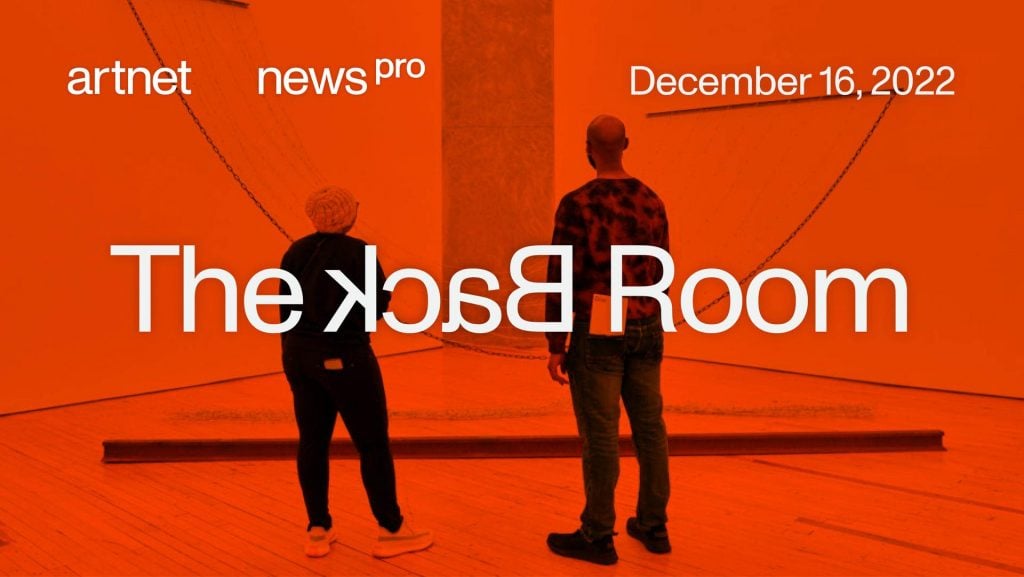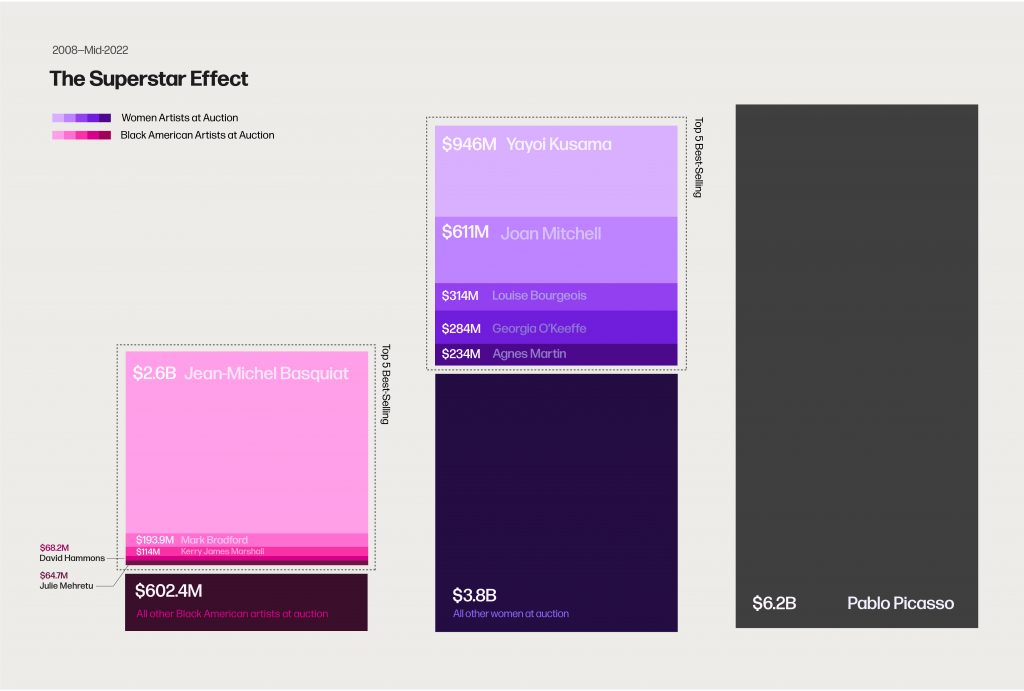The Back Room
The Back Room: Don’t Believe the Hype
This week: a sobering survey of gender and racial equity, Munich says ‘nein’ to Shepard Fairey, a Met director mouths off from beyond the grave, and much more.

This week: a sobering survey of gender and racial equity, Munich says ‘nein’ to Shepard Fairey, a Met director mouths off from beyond the grave, and much more.

Artnet News

Every Friday, Artnet News Pro members get exclusive access to the Back Room, our lively recap funneling only the week’s must-know intel into a nimble read you’ll actually enjoy.
This week in the Back Room: a sobering survey of gender and racial equity, Munich says ‘nein’ to Shepard Fairey, a Met director mouths off from beyond the grave, and much more—all in a 6-minute read (1,520 words).
__________________________________________________________________________

A visitor poses in an exhibition of work by artist Barbara Kruger at the Museum of Modern Art (MoMA) in New York on August 3, 2022. (Photo by ANGELA WEISS/AFP via Getty Images)
Readers of this newsletter know all too well that the art world tends to treat intellectual and moral superiority as an Olympic sport. In recent years, the day-to-day discourse has led many art professionals to believe that the industry should be awarded the gold medal for the longjump it has made in matters of racial and gender equity.
The self-congratulatory klaxon has even been loud enough to trigger some vocal backlash, with certain factions asking whether museums, galleries, and collectors have gone too far in their efforts to rebalance the scales in favor of female-identifying and BIPOC artists.
Well, a deafening “nope” should interrupt all parties defending the status quo with that question and all art professionals ready to take a victory lap for the industry’s supposed equity evolution.
This is the overarching conclusion of the Burns-Halperin Report, a multi-pronged, data-led study published this week by Artnet News’s executive editor Julia Halperin and Charlotte Burns, the veteran journalist and founder of Studio Burns.
At the core of the Burns-Halperin Report is a database made up of hundreds of thousands of entries quantifying sales results, exhibition credits, and gallery representation for three demographics: female-identifying artists, Black American artists, and Black American female-identifying artists.
The data covers acquisitions and exhibitions at 31 U.S. museums between 2008 and 2020, global auction results between 2008 and mid-2022, and recent roster figures and sales at four leading commercial galleries (Hauser and Wirth, Lisson, Pace, and David Zwirner).
The results are sobering to say the least.
Yes, there is some evidence of modest positive change. For instance, consider…
However, these figures vastly overstate the amount of actual progress made toward gender and racial equity.
The percentage increases are so large precisely because these three groups still make up such a tiny fraction of overall sales under the hammer. Misperceptions of meaningful change are further warped by the superstar effect (as Julia shows in this week’s Data Dip below).
A similar story holds true on the institutional side. Here are the big-picture facts in the data:
__________________________________________________________________________
The data in the Burns-Halperin Report proves that the narrative of imminent gender and racial equity in the art world is largely a myth, and that misinformation about the scale of the gains undermines efforts to implement policy changes that could actually move the needle over time.
Panning out, museum acquisitions by female-identifying and Black American artists are each around one-fifth of what they would be if collections actually represented the current U.S. population. That stat plunges to just 0.5 percent for artists in the intersection of both groups.
And the long view for auction sales? At the current rate, there would not be parity for women artists in the auction market until 2053.
So, suffice it to say that any self-congratulations about art-world equity are premature. Urgent action at a grand scale is required to redress the situation—and even still, it will take generations to move the needle.
Coming up soon, the latest Wet Paint will travel to Munich to investigate why Shepard Fairey’s first solo show in Germany may be shut down—and why local artists may think that’s for the best. It’ll also serve up details on tastemaking gallery Clearing’s new space on the Bowery, opening in February.
Here’s what else made a mark around the industry since last Friday morning…
Art Fairs
A scammer has been posing as top collector Alfonso de Angoitia Noriega to secure works from top tier galleries at art fairs around the world. (Artnet News Pro)
TEFAF announced the 10 exhibitors slated for the Showcase section of its Maastricht flagship event (March 11–19), including Ambrose Naumann Fine Art (U.S.), Callisto Fine Arts (U.K.), and Frederick Mouraux Gallery (Belgium). (Press release)
Auction Houses
Three houses reported all-time-high annual sales results for 2022: $1.3 billion for Phillips; $228.4 million for Artcurial; and a projected $8 billion for Sotheby’s … but only with the help of revenue streams nonexistent last year. Strip those away, and the House of Drahi’s $6.4 billion total underperformed last year’s equivalent by $900 million. (Press releases / Artnet News)
Galleries
Hauser and Wirth more than doubled presale expectations for its auction benefiting the U.N.‘s refugee relief program, with a net income of $4.6 million. Works by Rita Ackermann and Anj Smith outperformed the artists’ top results in for-profit auctions. (Artnet News)
A New York District Court jury ordered Pace to pay $6.3 million in damages to real-estate firm CBRE to resolve a years-long dispute over alleged unpaid fees concerning the gallery’s search for a new global headquarters in 2014–15. (Artnet News)
Institutions
The Met became the institutional epicenter of Philip Guston’s legacy thanks to a gift of 220 works and a $10 million donation from the artist’s daughter and son-in-law, Musa and Thomas Mayer. (Artnet News)
On the union front: unionized workers at MASS MoCA voted to ratify a new contract with museum management after 14 months of negotiations; and faculty at the New School reached a “tentative” agreement on a deal to end their month-long strike. (WAMC, Artforum, TAN)
NFTs and More
A class action lawsuit alleges that Bored Ape Yacht Club creator Yuga Labs “deliberately inflated the value of its NFTs to the benefit of insiders” with celebrity promotions by Madonna, Justin Bieber, Stephen Curry, Serena Williams, and Jimmy Fallon, who are all named in the suit. (Artnet News)
____________________________________________________________________________
“My collecting style was pure piracy… and I got a reputation as a shark.”
—Thomas Hoving, ex-director of the Met, describing his skill at dodging the law in the global pursuit of masterpieces during his lifetime. In the 1970s, he claimed that his skulduggery included smuggling a Romanesque relief from a Florentine church out of Italy with a dealer who concealed valuable objects under a mattress in his station wagon. (New York Times)

Graphic by Nehema Kariuki. Courtesy of the Burns-Halperin Report 2022 and Artnet Analytics. © 2022 Artnet Worldwide Corporation.
The Superstar effect, in which a small number of top performers buoy an entire market, is evident throughout the art trade. But as the 2022 Burns-Halperin Report makes plain, it is amplified in the case of artists from historically underrepresented demographics.
This chart makes clear that, in a winners-take-all economy like the art market, growth is often limited to the very top end, skewing our perception of how much is actually changing. The good news, however, is that there are a lot more artists beneath the leaderboard who are worthy of a closer look.
— Julia Halperin
____________________________________________________________________________